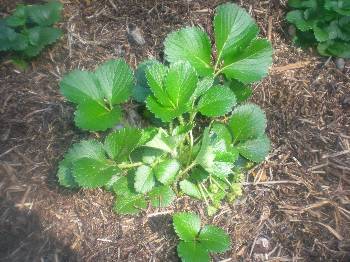| item(s), Total: $0.00 View Cart |
| Shopping cart is empty. |
Hi There and welcome to our first ever e-newsletter!
We would welcome your ideas and suggestions on topics you would like to see covered in future articles. Thank you & we look forward to hearing from you! Cheers, In this newsletter: Jobs for the garden this Spring/Summer SPECIAL OFFER for our newsletter readers!!
Spring has certainly sprung, and it is the perfect time to get busy in the garden. All around, things are bursting with life (especially the weeds!) and the warmer, longer days are making things grow vigorously. Here are a few things which you may need to address at this time of year:
There are a huge range of summer vegies and herbs which will grow well if planted out now: See our ‘When to Sow’ Chart and other great gardening fact sheets. We are receiving new seedling stock every week, with more and more summer vegies coming on stream. We have loads of heritage tomato varieties available, see below for our 'review' of a few types.
For some really interesting salads over summer, try growing Mizuna (red and green forms available), Mibuna, Tatsoi, Mustard greens (hot & spicy!), Chicory, Corn Salad, Endive, Radicchio, Rocket & Wild Rocket, and Water Cress (which must have wet feet, but doesn't need to be grown in water). And young Beetroot leaves are tasty and colourful in a salad, with the added bonus of the beet too, once mature!
This summer is potentially going to be a long, hot one if this spring is anything to go by. With talk in the media of further water restrictions, we all need to assess our garden beds, perhaps cull things that are marginal, and ensure our soil will hold onto whatever water we apply. Our Sand Remedy is a mixture of natural minerals, one of which is bentonite clay. Bentonite can hold many times its own weight in water, and bonds with sand particles to create a loamy soil. While soil treated with Sand Remedy will still dry out, the clay particles make it much easier to re-wet, acting much like a sponge. The other minerals in Sand Remedy work with bentonite to ensure that water and nutrients are more available to plants, meaning your garden will be as ‘summer proofed’ as possible. Digging in compost and other quality organic matter will also be beneficial. Once you have addressed the soil, it is time to think about which mulch to use on top. Mulch can be just about anything; pebbles and stones make a very low maintenance mulch and of course last just about forever! The best mulches are light coloured (to reflect heat rather than absorb it); and are made from large particles. Coarse textured mulches allow water to easily penetrate between the gaps and don’t tend to mat together and restrict water penetration. Always ensure there is a gap around stems of plants to ensure airflow. Damp mulch right up against stems and trunks can cause the plant to rot. One of the best general purpose mulches for shrubs, trees, fruit trees, etc. is the coarse wood chip/tree pruning mulch. This is available fairly cheaply, so you can afford to put it down nice and thick. 10 – 15 cms is usually a good depth. This much woody mulch put down over a layer of moist compost produces a fantastic soil over time; usually full of worms! A concern with using fresh woodier mulch is ‘nitrogen drawdown’. Basically, in the breakdown process of the mulch, the microbes fuel up on nitrogen; often from the soil, meaning that it isn’t available to plants. However, once this part of the cycle is over, the microbe population dies down, and releases the nitrogen into the soil once more. If you are particularly concerned about nitrogen drawdown, simply sprinkle a light layer of blood and bone on the soil, underneath the mulch. This will feed up the microbes and your plants won’t suffer.
Always water your soil well BEFORE putting down mulch. If you are mulching over weeds, a layer of wet newspaper (at least 10 sheets thick) forms a great barrier. Soak the newspaper in a wheel barrow or similar before laying it in overlapping sections on the ground, then apply your mulch straight on top. Should you need to plant into it, simply puncture the layer of paper and plant away! If you really prefer the look of darker mulch, we do carry ‘Economulch’. This too is made from tree waste, but has gone through an extra grinding process so particles are smaller and more even, and the ageing process means it is a uniform brown colour. It will fade over time, as all mulches do. Please note we do NOT carry or recommend peat mulch. Peat is extracted from wetland areas and is a non-renewable resource. It is also interesting to note that some of the cheaper black mulches are actually DYED – often with a petrochemical based product (diesel has been known to be used!). Not particularly environmentally friendly either! So perhaps we need to break with the tradition of using ‘black mulch’ for a product that both does the job better, is longer lasting, and is less expensive costwise and environmentally… it just isn’t black!
Who can resist the taste of a fresh, home grown tomato? It doesn’t fail to blow me away every year when we pick the first off the bush just how the taste compares to the red, wet things we get from the supermarket the rest of the year! There are a HUGE number of heirloom tomato varieties available; we are often asked which is the “best”….. Of course there is no real answer to such a subjective question. And we are the first to admit we haven’t even tried the vast majority of them… So we’d be interested in YOUR recommendations! Some of those we have grown and can vouch for are: Moneymaker Green Zebra Brandywine Yellow Cherry Grosse Lisse Black Russian San Marzano And if you still need more inspiration, have a look at Eden Seed’s website for descriptions and pictures of some 150 plus varieties (it will do your head in!).
Types of tomatoes: Indeterminate and Determinate. Indeterminate types tend to be taller (require staking), and often produce progressively over a longer period. We have found they just keep going. Determinate types are more of a 'bush', lower growing, but still may need staking. Often determinite types will tend to fruit all at once, and may not be so long lived. Great if you want to hit peak production at once for bottling or preserving. Staking tomatoes is something to keep them 'tidy'; - plants will hapily grow unstaked but you will need to spend a bit more time hunting the fruit. We have found this actually helps with sun protection of the fruit, too. Cherry tomatoes tend to be less prone to sunburn, due to their smaller surface area. Pinching out tips of growing tomatoes is something some people do to keep them bushy and make the plant produce more lateral, fruiting branches. It is a personal preference really - some people swear by the practice - others (like us) usually forget and still seem to get enough fruit to keep them happy. A tip for growing: Tomatoes really need CONSISTENT watering. That means if you water every third day in the morning, stick to that time of day. Chopping and changing watering times and intervals between watering can cause Blossom End Rot ; which is exactly what it sounds like. Soft, rotting tissue at the flower end of the fruit. A light sprinkling of dolomite lime can help (it’s the calcium that does the job) . And don’t forget the basil! It will do really well if planted now. Besides being great companion plants, they make an unbeatable flavour combination! Try grilling tomatoes sliced in half, sprinkled lightly with salt, sugar, pepper and chopped basil. Yum!
A micro climate simply means different pockets of your garden that are seasonally warmer, cooler or windier than others. An awareness of these pockets can help you extend growing and fruiting seasons, or grow things which would otherwise struggle. Creating different microclimates in your garden is another way you can help reduce water use and ensure plants survive in our climate. Pockets within your garden can be made to shelter plants from frost, allow more or less sunlight in, and protect from strong winds. With a little sleuthing and observation, you can look at what already exists in your garden (trees, shrubs etc.) and work with these elements to improve growing areas around them. Some obvious ways to do this is by structures (pergolas, trellises, etc.) and using shadecloth to control how much sun you want to allow in. Shade cloth can be removeable in winter and used temporarily while trees are given time to grow. Did you know a row of densely planted trees and shrubs makes an excellent windbreak, protecting an area at least 10 times its height? (Ie. A hedge 2m high will protect an area of 20m behind it.) Windbreaks that slow the wind actually provide more protection than those that don’t allow air to penetrate (ie. A fence or wall). Within your vegie patch, shade and windbreaks can be provided even with straw bales! These are quite often useful when plants are quite small or during periods of extreme conditions, and can be simply moved around. Or they can be arranged in a northfacing “nook” to create a suntrap to help plants grow when conditions are a little colder than you would like. Larger suntraps, with a heat reflective wall make great places to sit in winter. These walls soak up heat and radiate it back at night. This means tomatoes, capsicums, etc. can have a much longer growing season here than they could elsewhere in your garden. Also, plants and herbs can be kept in pots here and simply moved around when conditions change. If the heat of a north facing wall is too much for summer, try a trellis with a vine to provide shelter to your house. A deciduous vine will give you the best of both worlds – summer protection and winter warmth. East facing walls tend to be a good spot to grow more sensitive plants. Here, they will get good light, but not as much heat. West facing and north facing plants get more sun and warmth – a trick that helps ensure sweeter grapes! If frosts are a problem for you, there are tricks to help raise temperatures slightly in various pockets of your garden. Areas under eaves and tree canopies stay a little warmer, as do areas next to ponds or dams. Water retains heat longer so provides some protection to surrounding plants. Also, light reflected off the water can provide additional light for growth. In summer, areas next to ponds are always a little cooler, due to evaporation. These are some basic considerations which may be helpful. Plenty of good books and websites offer ideas for garden planning and design, incorporating these ideas. (Just remember if they’re from the northern hemisphere to reverse what they are saying about ‘north’ and ‘south’.)
If you are still living on Silverbeet from your garden (I find it is one of the staples that keeps going through that ‘lean’ time when everything else is still too small to be producing, but winter vegies are almost done) – you might like to try this brilliant recipe for Silverbeet Pie. I can’t claim to have made it up; I am no Masterchef; but it’s a great vegetarian recipe that when served with a crisp salad will have everyone impressed. (Its based on one of Alison & Simon Holst's great vegetarian recipes) I have made this pie about a million times (well, slight exaggeration perhaps) and it is always reliably good to eat. It makes great leftovers for lunch the next day and survives reheating in a microwave or can be eaten cold. To make a pie approx 30cms x 20cms (I do it in a roasting pan as my rectangular casserole dishes tend to be a bit shallow) which will serve 4 – 6 people depending on appetites, you will need: Ingredients:
Method: Wash Silverbeet to remove any grit and caterpillars (a sign of good organically grown produce!). Break off stalks and rip up leaves into largish chunks. Steam leaves until just tender. Allow to cool, then squeeze out as much water as possible (you will be surprised how much comes out) – I use a colander and my hands to do this. In a large bowl, lightly beat the eggs then add the cottage cheese, grated cheese, salt pepper & nutmeg, and then the Silverbeet. Mix together. Arrange half the pastry on the bottom of your dish, spread the filling mix inside, then use the remaining pastry on top. Brush the top with butter if desired. Bake at 180 degrees for approx 40 minutes until top is lightly browned. Allow to stand for 5 minutes before cutting into squares and serving. Enjoy!
Special Sand Remedy offer for our Newsletter readers!
Limit of one per customer, only valid at our store. Please mention this offer, and we will take your name as confirmation. Now is the perfect time to give Sand Remedy a try.
So until next time – have a great time this Spring in the garden! Have fun, and Let’s get dirty! (Don't forget - we'd love your feedback on this newsletter! Please contact us with your comments!) Visit The Green Life Soil Co store or online shop for a range of garden products and organic garden supplies. |



 As this is our first newsletter, we’d really appreciate some feedback from you as to whether you enjoyed it and whether it was relevant to you.
As this is our first newsletter, we’d really appreciate some feedback from you as to whether you enjoyed it and whether it was relevant to you.
 We also have lots of strawberry varieties - if they are planted out now and given some TLC, you will be enjoying picking your own sweet fruit within weeks. My strawberry patch is coming along marvellously - here's a picture!!
We also have lots of strawberry varieties - if they are planted out now and given some TLC, you will be enjoying picking your own sweet fruit within weeks. My strawberry patch is coming along marvellously - here's a picture!!  For vegie gardens, straw and pea straw (shown around my beetroot plants here) are usually a better way to go. Straw breaks down quicker than the woodier mulch, adding valuable organic matter to the soil. Which to use (straw or pea straw) often comes down to a personal preference. Peas, being a nitrogen fixing plant, return more of this element to the soil when their material breaks down. However, if you are using our soils, and improving your soils organically from season to season, the extra nitrogen will have a minimal effect. The decision often comes down to cost. Straw is cheaper than pea straw. There is also the option of Lucerne, which is usually available from stock feed suppliers. However, this is more expensive again and the benefits of the nitrogen negligible if you are doing other things to improve your soil. We also carry bags of Lupin mulch. This is well shredded and easy to apply. I have used it around my strawberries this year, just as an experiment. (You can see it in the picture of the strawerry plant used above.) One 42L bag covered about 3m2.
For vegie gardens, straw and pea straw (shown around my beetroot plants here) are usually a better way to go. Straw breaks down quicker than the woodier mulch, adding valuable organic matter to the soil. Which to use (straw or pea straw) often comes down to a personal preference. Peas, being a nitrogen fixing plant, return more of this element to the soil when their material breaks down. However, if you are using our soils, and improving your soils organically from season to season, the extra nitrogen will have a minimal effect. The decision often comes down to cost. Straw is cheaper than pea straw. There is also the option of Lucerne, which is usually available from stock feed suppliers. However, this is more expensive again and the benefits of the nitrogen negligible if you are doing other things to improve your soil. We also carry bags of Lupin mulch. This is well shredded and easy to apply. I have used it around my strawberries this year, just as an experiment. (You can see it in the picture of the strawerry plant used above.) One 42L bag covered about 3m2. How many plants? Well last year we packed in about eight plants into a circular area about 2.5m across. We were picking a large colander full every 2 - 3 days so we were more than self sufficient; in fact we had plenty to give away.
How many plants? Well last year we packed in about eight plants into a circular area about 2.5m across. We were picking a large colander full every 2 - 3 days so we were more than self sufficient; in fact we had plenty to give away. If you have read this far, you deserve a reward!! Up until 31st December 2010, we are giving you the opportunity to try Sand Remedy at a reduced price. A 5kg tub is normally $32; we are letting you have it for $25.
If you have read this far, you deserve a reward!! Up until 31st December 2010, we are giving you the opportunity to try Sand Remedy at a reduced price. A 5kg tub is normally $32; we are letting you have it for $25. 




















